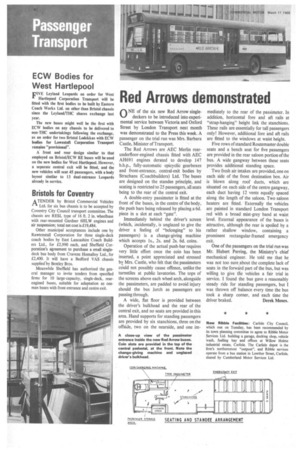Red Arrows demonstrated
Page 46

If you've noticed an error in this article please click here to report it so we can fix it.
ONE of the six new Red Arrow singledeckers to be introduced into experimental service between Victoria and Oxford Street by London Transport next month was demonstrated to the Press this week. A passenger on the trial run was Mrs. Barbara Castle, Minister of Transport.
The Red Arrows are AEC Merlin rearunderfloor-engined chassis fitted with AEC AH691 engines derated to develop 147 b.h.p., fully-automatic epicyclic gearboxes and front-entrance, central-exit bodies by Strachans (Coachbuilders) Ltd. The buses are designed on the standee principle, and seating is restricted to 25 passengers, all seats being to the rear of the central exit.
A double-entry passimeter is fitted at the front of the buses, in the centre of the body, the push bars being released by placing a 6d. piece in a slot at each "gate".
Immediately behind the driver's screen (which, incidentally, is unglazed to give the driver a feeling of "belonging" to his passengers) is a change-giving machine which accepts 1s., 2s. and 2s. 6d. coins.
Operation of the actual push-bar requires very little effort once the coin has been inserted, a point appreciated and stressed by Mrs. Castle, who felt that the passimeters could not possibly cause offence, unlike the turnstiles at public lavatories. The tops of the screens above each wheel arch, alongside the passimeters, are padded to avoid injury should the bus lurch as passengers are passing through.
A wide, fiat floor is provided between the driver's bulkhead and the rear of the central exit, and no seats are provided in this area. Hand supports for standing passengers are provided by six stanchions, three on the offside, two on the nearside, and one im mediately to the rear of the passimeter. In addition, horizontal fore and aft rails at "strap-hanging" height link the stanchions. These rails are essentially for tall passengers only! However, additional fore and aft rails are fitted to the windows at waist height.
Five rows of standard Routemaster double seats and a bench seat for five passengers are provided in the rear saloon portion of the bus. A wide gangway between these seats provides additional standing space.
Two fresh air intakes are provided, one on each side of the front destination box. Air is blown along roof ducts, which are situated on each side of the centre gangway, each duct having 12 vents equally spaced along the length of the saloon. Two saloon heaters are fitted. Externally the vehicles are painted in standard London Transport red with a broad mist-grey band at waist level. External appearance of the buses is attractive, although the rear is spoiled by a rather shallow window, containing a prominent rectangular-framed emergency exit.
One of the passengers on the trial run was Mr. Hubert Perring, the Ministry's chief mechanical engineer. He told me that he was not too sure about the complete lack of seats in the forward part of the bus, but was willing to give the vehicles a fair trial in service. I found the bus gave a reasonably steady ride for standing passengers, but I was thrown off balance every time the bus took a sharp corner, and each time the driver braked. Derek Moses.
New Ribble Facilities: Carlisle City Council, which met on Tuesday, has been recommended by its town planning committee to agree to Ribble Motor Services Ltd. building a garage, docking shop, vehicle Wash, fuelling bay and offices at Willow Holme industrial estate, Carlisle. The Carlisle depot is the firm's northernmost "outpost". and Ribble services operate from a bus station in Lowther Street, Carlisle, shared by Cumberland Motor Services Ltd.








































































































































